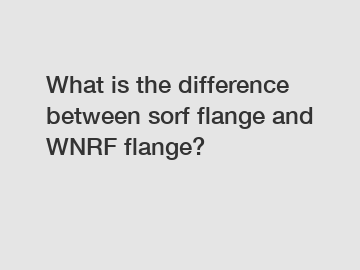What is the difference between sorf flange and WNRF flange?
If you want to learn more, please visit our website Fusion.
When it comes to connecting pipes, flanges play a crucial role in providing a secure and leak-free joint. Different types of flanges are used in various industries depending on the specific requirements of a project. Two commonly used flanges are the Slip-On Raised Face (SORF) flange and the Weld Neck Raised Face (WNRF) flange. While both serve the same purpose, they possess distinct characteristics that make them suitable for different applications. In this article, we will delve into the differences between SORF and WNRF flanges, shedding light on their unique features, benefits, and ideal use cases.
1. Understanding the SORF Flange:

The SORF flange is designed to easily slip over the pipe and then be fillet-welded in place, thus ensuring a reliable and secure connection. This type of flange has a slightly larger diameter than the pipe to allow for an easy slip-on installation. SORF flanges are known for their simplicity, cost-effectiveness, and hassle-free fitting.
Key features of SORF flanges:
- Simplicity: SORF flanges are the most straightforward type of flanges to install, making them ideal for low-pressure applications.
- Cost-effective: SORF flanges are relatively inexpensive since they require minimal machining and welding.
- Easy alignment: These flanges align easily due to their slip-on design, saving valuable time during installation or maintenance.
2. Exploring WNRF Flanges:
On the other hand, WNRF flanges are designed to offer greater strength, reliability, and durability. These flanges are characterized by their long tapered neck that gradually merges with the pipe. The weld neck design ensures a smooth transition and minimizes stress concentration, making them suitable for high-pressure and high-temperature applications.
Key features of WNRF flanges:
- Superior strength: WNRF flanges provide excellent resistance against bending, cracking, and deformation due to their robust design.
- Enhanced tightness: The continuous neck and seamless connection between the flange and pipe reduce the risk of leaks, making WNRF flanges ideal for critical systems.
- High-pressure and high-temperature capacity: WNRF flanges are specifically engineered to handle extreme pressure and temperature conditions, making them suitable for industries such as oil and gas, petrochemicals, and refineries.
3. The Variation in Applications:
Based on their unique features, SORF and WNRF flanges find their application in different industries and scenarios.
Ideal applications for SORF flanges:
- Low-pressure systems: SORF flanges are commonly used in low-pressure systems, such as water supply networks, plumbing, and irrigation.
- Non-critical systems: Where cost-effectiveness and ease of installation take precedence over extreme conditions, SORF flanges are a popular choice.
Ideal applications for WNRF flanges:
- High-pressure and high-temperature systems: WNRF flanges find wide application in industries dealing with steam, gas, or fluid under high pressure and high temperature, such as power generation plants, chemical plants, and offshore platforms.
- Critical systems: When safety and reliability are of paramount importance, such as in the oil and gas industry, WNRF flanges deliver the necessary strength and integrity.
Conclusion:
In summary, the choice between SORF and WNRF flanges ultimately depends on the specific requirements of the application at hand. While SORF flanges offer simplicity and cost-effectiveness for low-pressure systems, WNRF flanges are engineered for high-stress environments. It is crucial to consider factors like pressure, temperature, fluid type, and system criticality before selecting the appropriate flange. By understanding the differences between SORF and WNRF flanges, you can make an informed decision, ensuring a successful and reliable pipe connection for your project.
You can find more information on our web, so please take a look.
If you want to learn more, please visit our website piping reducer.



